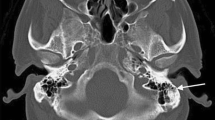Abstract
Temporal bone fractures are traditionally classified as transverse, longitudinal or mixed. Since these categories have shown little association with clinical symptoms, new classifications have been introduced, including those related to the involvement of the petrous bone and otic capsule. We have formulated a new classification based on the involvement of four parts of the temporal bone (squama, tympanic, mastoid, and petrous) and assessed which of these classification systems is the most rational using a retrospective chart review in hospital settings (KyungHee Medical Center, Seoul, Korea and Samsung Changwon Hospital, Changwon, Korea). The association between each classification and clinical symptoms was examined by analyzing temporal bone computed tomography scans of 129 patients diagnosed as temporal bone fractures over the past 7 years. Using the traditional classification, there was a significant correlation between transverse fractures and the incidence of sensorineural hearing loss. Patients with petrous bone fractures had significantly higher incidence rates of sensorineural hearing loss, vertigo, and eardrum perforation than patients without petrous bone involvement. Involvement of the otic capsule was significantly associated with sensorineural hearing loss and the severity of hearing loss. The associations of the traditional classification and the classification according to the involvement of the otic capsule, four parts of temporal bone with clinical symptoms were not high. Petrous bone fractures were significantly associated with sensorineural hearing loss, vertigo, and eardrum perforation, suggesting that this classification may be optimally associated with clinical symptoms including hearing and the results of otological examination.

Similar content being viewed by others
References
Ishman SL, Friedland DR (2004) Temporal bone fractures: traditional classification and clinical relevance. Laryngoscope 114:1734–1741
Rafferty MA, Mc Conn Walsh R, Walsh MA (2006) A comparison of temporal bone fracture classification systems. Clin Otolaryngol 31:287–291
Brodie HA, Thompson TC (1997) Management of complications from 820 temporal bone fractures. Am J Otol 18:188–197
Jennett B, Teasdale G, Fry J et al (1980) Treatment for severe head injury. J Neurol Neurosurg Psychiatry 43:289–295
Harker LA, McCabe BF (1974) Temporal bone fracture and facial nerve injury. Otolaryngol Clin North Am 7:425–431
Kerman M, Cirak B, Dagtekin A (2002) Management of skull base fractures. Neurosurgery 12:23–41
Darrouzet V, Duclos JY, Liquoro D et al (2001) Management of facial paralysis resulting from temporal bone fractures: our experience in 115 cases. Otolaryngol Head Neck Surg 125:77–84
Gordon HS, Nael MS, Ravi NS, Rebecca SC, Bernadette LK, Myles LP (2011) Do contemporary temporal bone fracture classification systems reflect concurrent intracranial and cervical spine injuries? Laryngoscope 121:929–932
Chakeres DW, Spiegel PK (1983) A systematic technique for comprehensive evaluation of the temporal bone by computed tomography. Radiology 146:97–106
Saraiya PV, Aygun N (2009) Temporal bone fractures. Emerg Radiol 16:255–265
Dahiya R, Keller JD, Litofsky NS et al (1999) Temporal bone fractures: otic capsule sparing versus otic capsule violating clinical and radiographic considerations. J Trauma 47:1079–1083
Little SC, Kesser BW (2006) Radiographic classification of temporal bone fractures: clinical predictability using a new system. Arch Otolaryngol Head Neck Surg 132:1300–1304
Johnson F, Semaan MT, Megerian CA (2008) Temporal bone fracture: evaluation and management in the modern era. Otolaryngol Clin N Am 41:597–618
Park SY, Yang JW, Kim SI et al (2007) Clinical study on the reliable temporal bone fracture classification scheme. Korean J Otolaryngol 50:491–495
Author information
Authors and Affiliations
Corresponding author
Additional information
H. M. Kang and M. G. Kim contributed equally to this work.
Rights and permissions
About this article
Cite this article
Kang, H.M., Kim, M.G., Boo, S.H. et al. Comparison of the clinical relevance of traditional and new classification systems of temporal bone fractures. Eur Arch Otorhinolaryngol 269, 1893–1899 (2012). https://doi.org/10.1007/s00405-011-1849-7
Received:
Accepted:
Published:
Issue Date:
DOI: https://doi.org/10.1007/s00405-011-1849-7




